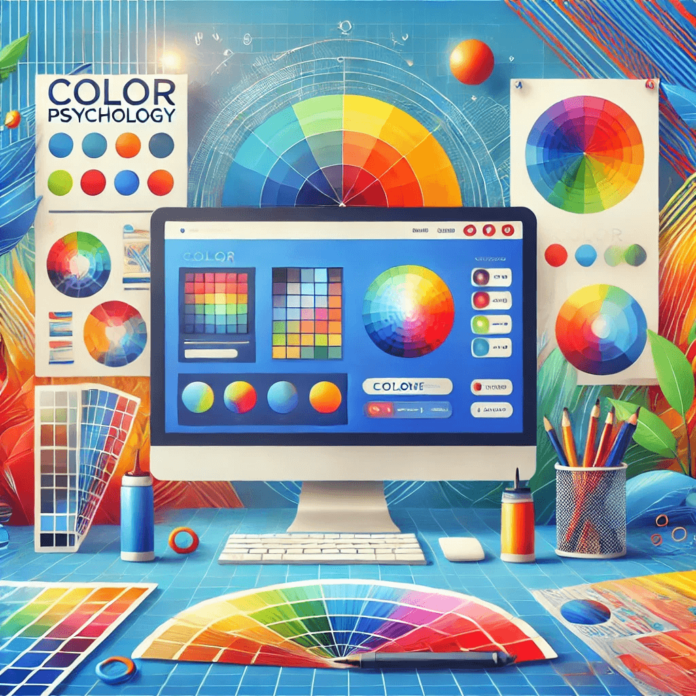Introduction
- Why Color Psychology Matters in Web Design
- The Psychology of Colors
- How to Choose the Perfect Colors for Your Website Design
- Color Schemes and Their Impact on UX
- Color in Calls-to-Action (CTAs)
- Case Studies: Proven Strategies for Leveraging Color in Web Design to Boost Engagement
- Common Mistakes in Using Color Psychology
- How to Test and Optimize Color Choices
- Future Trends in Color Psychology for Web Design
- Understanding Color Psychology in Web Design
- Conclusion
- Questions
Creating an effective website involves more than just functionality—color psychology in web design plays a pivotal role in shaping user behavior. By selecting the right website color schemes, you can evoke emotions, build trust, and guide visitors toward desired actions. From boosting engagement to improving conversions, understanding how colors influence user behavior can transform your web design strategy. Whether it’s calming blues for trust or vibrant reds for urgency, this guide explores how to harness the power of color in your website design.
Why Color Psychology Matters in Web Design
Colors are more than just visual elements; they are powerful psychological tools that influence emotions, perceptions, and actions.
- First Impressions: Users form opinions about your site within seconds, and colors play a key role in that judgment.
- Brand Identity: Consistent use of brand colors builds recognition and trust.
- User Behavior: Specific colors can encourage actions like clicking a button or signing up.
The Psychology of Colors
Different colors evoke unique emotional responses. Here’s a breakdown:
- Red: Associated with energy, urgency, and passion. Often used for sales or warnings.
- Blue: Conveys trust, stability, and calmness. Popular among tech and financial brands.
- Yellow: Represents optimism and happiness. Works well for attention-grabbing elements.
- Green: Symbolizes growth, harmony, and health. Commonly used in eco-friendly or financial contexts.
- Black: Denotes luxury, sophistication, and power. Ideal for high-end brands.
- White: Represents simplicity and cleanliness. Often used in minimalist designs.
How to Choose the Perfect Colors for Your Website Design
- Understand Your Audience: Different demographics have unique emotional and cultural responses to colors, influencing their preferences and engagement.
- Younger users may prefer vibrant hues.
- Professional audiences might gravitate toward neutral tones.
- Align with Your Brand Identity:
- Ensure the colors reflect your brand’s personality.
- Use primary brand colors consistently across the site.
- Test and Iterate: Conduct A/B testing to see which color schemes perform best for user engagement.
Color Schemes and Their Impact on UX
- Monochromatic Schemes: Utilize shades and tones of a single color to create a harmonious and unified visual design.
- Impact: Simplicity and focus.
- Analogous Schemes: Combines colors adjacent to the color wheel.
- Impact: Harmony and comfort.
- Complementary Schemes: Pairs opposite colors for contrast.
- Impact: Bold and attention-grabbing.
Color in Calls-to-Action (CTAs)
Effective CTAs are highly dependent on color choices.
- Use Contrasting Colors: Ensure CTAs stand out against the background.
- Red for Urgency: Perfect for creating urgency on buttons like “Act Now” or “Shop Today” to encourage immediate action.
- Green for Action: Encourages progress and positivity for “Get Started” or “Sign Up.”
Case Studies: Proven Strategies for Leveraging Color in Web Design to Boost Engagement
- E-Commerce Store Example:
- Challenge: Increase cart conversions.
- Solution: Used green CTAs to promote trust and progress.
- Result: Conversion rates increased by 15%.
- Health and Wellness Brand:
- Challenge: Build trust and a sense of calm.
- Solution: Leveraged blue and white tones for a clean, professional aesthetic.
- Result: Improved user engagement by 20%.
Common Mistakes in Using Color Psychology
- Overwhelming Users: Using too many colors can confuse users and dilute the message.
- Ignoring Accessibility: Ensure text contrasts sufficiently with backgrounds for readability.
- Mismatched Branding: Colors should align with the brand’s message and target audience.
How to Test and Optimize Color Choices
- A/B Testing: Experiment with different color schemes for key elements like CTAs or headlines.
- Heatmaps: Use tools like Hotjar to analyze how users interact with colored elements.
- Surveys and Feedback: Gather user input on color preferences.
Future Trends in Color Psychology for Web Design
- Dynamic Color Palettes: Adapting colors based on user preferences or time of day.
- Neon Accents: Adding vibrant neon hues to create a modern, tech-savvy aesthetic.
- AI-Driven Customization: Using artificial intelligence to suggest personalized color schemes.
Understanding Color Psychology in Web Design

Color psychology in web design is the practice of leveraging colors to influence user emotions, perceptions, and actions. Colors evoke specific feelings and reactions, making them a powerful tool for guiding user behavior and enhancing the overall user experience.
How Colors Impact User Behavior
- Trust and Calmness with Blue: Blue is often associated with trust, reliability, and calmness, making it a popular choice for financial and healthcare websites.
- Energy and Urgency with Red: Red captures attention and evokes urgency, ideal for sales or call-to-action buttons.
- Positivity and Growth with Green: Green symbolizes growth, health, and harmony, commonly used by eco-friendly and wellness brands.
- Luxury and Sophistication with Black: Black conveys sophistication and elegance, often seen in high-end fashion or luxury websites.
By understanding these psychological triggers, designers can create a website that aligns with their brand message and encourages desired user interactions.
Conclusion
Color psychology in website design is a powerful tool for influencing user behavior and enhancing engagement. By understanding the emotions tied to different colors and applying them strategically, you can create a website that not only looks great but also drives meaningful actions. Whether you’re building brand trust with blue tones or encouraging urgency with red accents, the right color choices can transform user experience and boost your business’s success.
Questions
Q: How does color psychology influence user behavior on websites?
A: Color psychology impacts how users perceive and interact with your website. Colors evoke emotions and reactions—for example, blue promotes trust, red creates urgency, and green symbolizes growth.
Q: Which colors are best for call-to-action (CTA) buttons?
A: Bright and contrasting colors like red, orange, or yellow are highly effective for CTA buttons. These colors grab attention and create a sense of urgency, encouraging users to take immediate action. Ensure the color contrasts with the background for visibility.
Q: How can I choose the right color scheme for my website?
A: Start by considering your brand identity and target audience. Research color meanings and their psychological effects to align with your brand’s goals.
Q: Can color choices affect SEO and website performance?
A: While colors themselves don’t impact SEO directly, their effect on user experience (UX) can influence key metrics like bounce rates, dwell time, and conversions.
Q: How do cultural differences impact color psychology?
A: Cultural perceptions of colors vary widely. For example, white symbolizes purity in Western cultures but may represent mourning in some Asian cultures.














